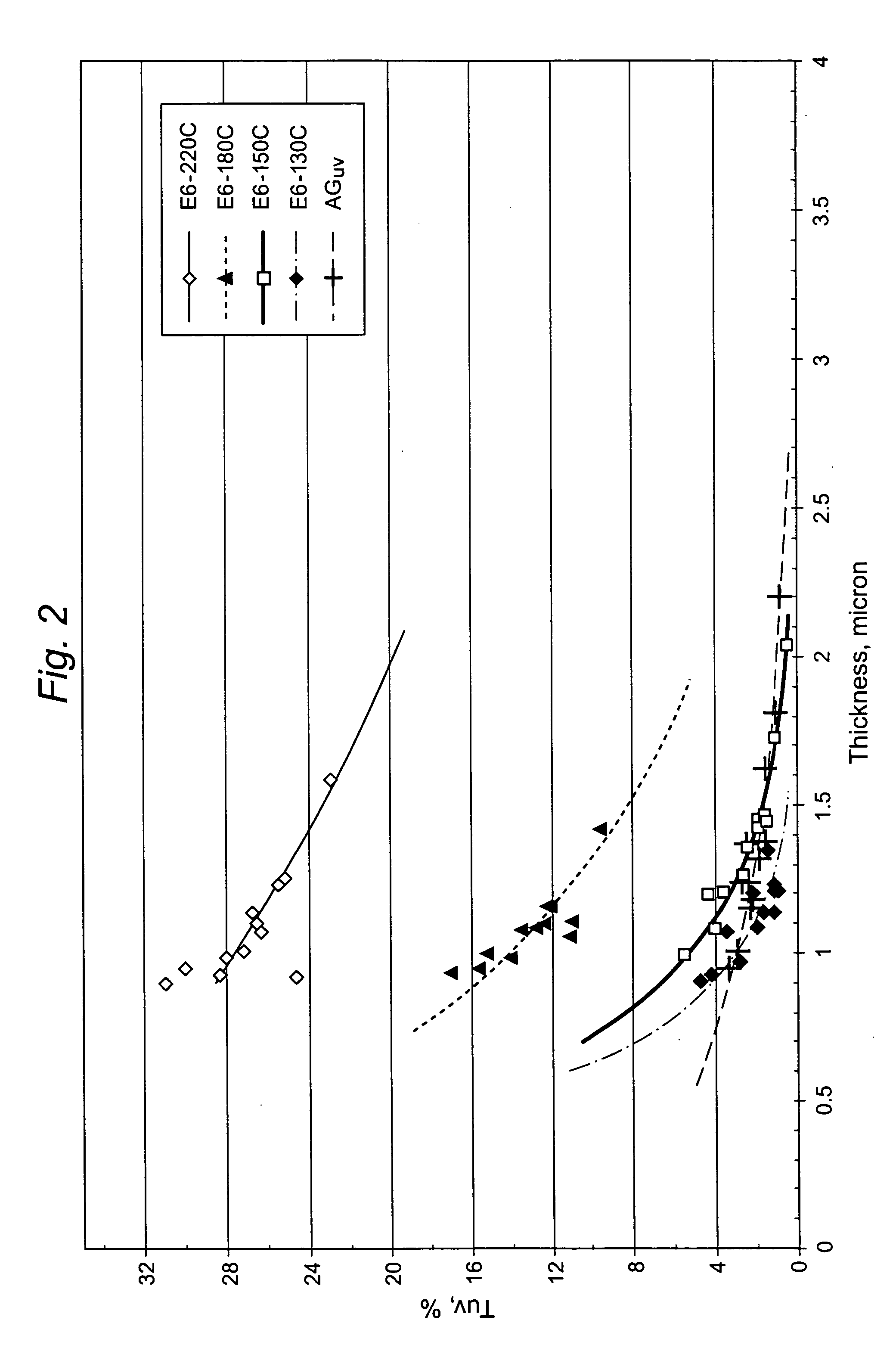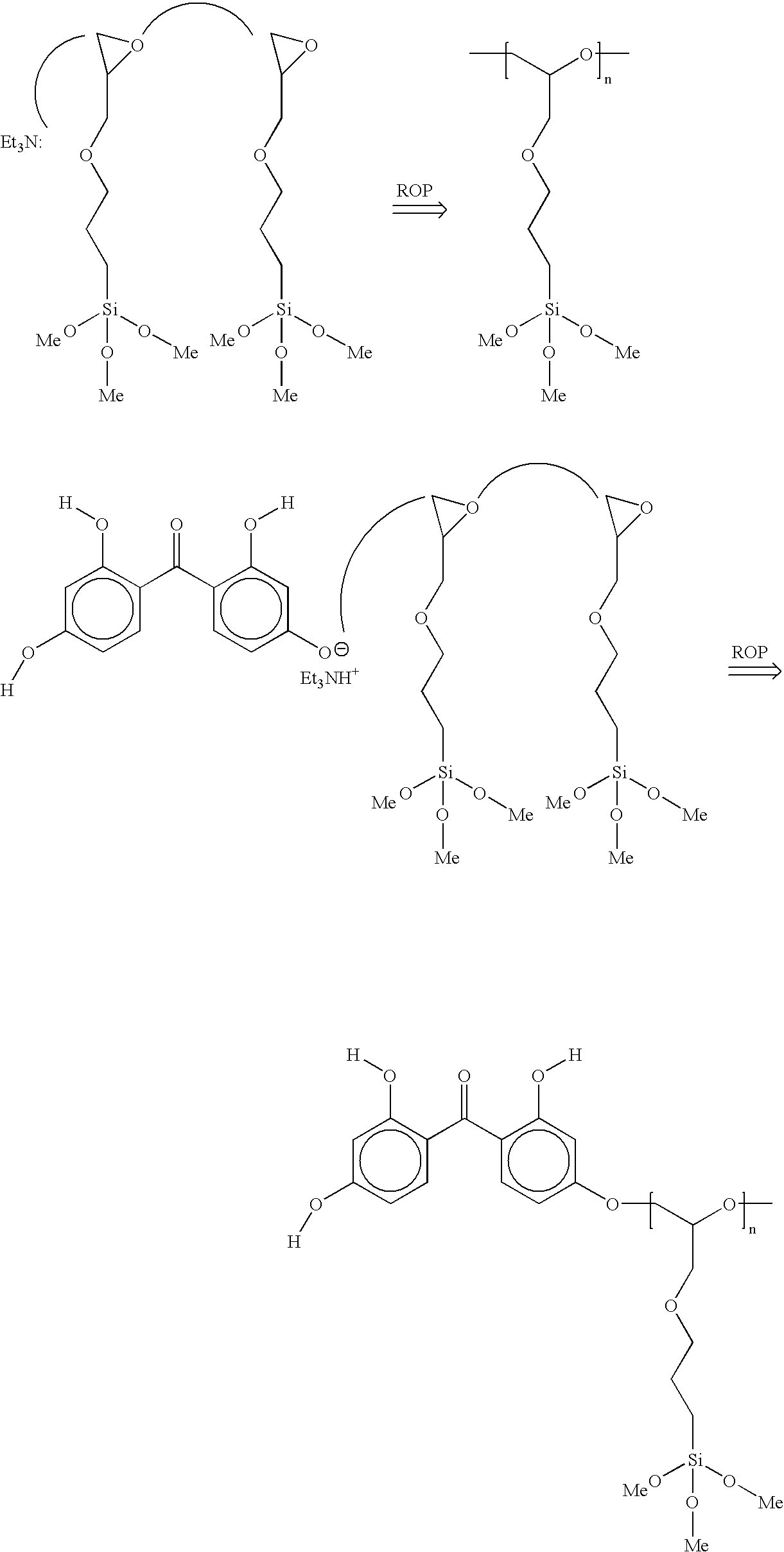UV-absorbing coatings and methods of making the same
a technology of protective coatings and coatings, applied in the field of ultraviolet absorption protective coatings, can solve the problems of longer component life, achieve the effects of reducing production line temperatures, improving productivity, and increasing production line speeds
- Summary
- Abstract
- Description
- Claims
- Application Information
AI Technical Summary
Benefits of technology
Problems solved by technology
Method used
Image
Examples
example 1
[0025] To a 150 ml round-bottom flask equipped with a condenser and under N2 was added tetrahydroxybenzophenone (D50) in an amount of 9 g (36 mmol) and 3-glycidoxypropyltrimethoxysilane (glymo) in an amount of 17.1 g (72 mmol) to provide a 1:2 molar ratio of D50 to Glymo. The mixture was heated to 80° C. with stirring. The D50 did not dissolve in glymo at this temperature. Triethylamine (TEA) (0.1 moles vs. D50) was added via syringe. The D50 slowly dissolved (reacted) with glymo and the solution became clear. The viscosity of the clear solution increased with time. After 3 hours, the solution was allowed to cool to room temperature. The resulting viscous solution was thereafter dissolved in 30 ml n-propanol.
example 2
[0026] Example 1 was repeated to obtain several additional samples using the molar ratios of D50 and glymo and reaction times. The samples made in accordance with Example 1 and in accordance with this Example 2 are identified in Table 1 below as sample numbers E1-E7, respectively.
TABLE 1CatalystMolar Ratio(Et3N)Reaction temp.ReactionNo.D50 to Glymo(moles vs. D50)(° C.)time (hr)E11:20.1 moles vs. D50803E21:1″″1.5E31:2″″2E41:3″″3E51:4″″5E61:5″″5E71:6″″5
[0027] Samples E2-E7 obtained from this Example 2 were tested for UV absorption characteristics. The UV absorption data appear in FIG. 1.
example 3
[0028] To a 250 ml round-bottom flask equipped with a condenser and under N2 were added D50, glymo and a solvent n-propanol (n-PrOH) in the amounts noted below in Table 2 to produce samples E1-S through E8-S. The reaction mixture was heated to 90° C. with stirring. The D50 slowly dissolved in the glymo and the solution became clear. Triethylamine (TEA) (0.1 moles vs. D50) was added via syringe after complete dissolution. The viscosity of the clear solution increased with time. After a selected reaction time, the reaction product was allowed to cool to room temperature. A total of 40 ml of n-PrOH was added to the resulting reaction product, and the solution was transferred from reaction flask to a polypropylene bottle. Additional n-PrOH was added and the transfer process repeated until a total of 150 ml was used.
TABLE 2CatalystReactionYield (%)Molar RatioSolvent(Et3N)temp.Reaction7.316.42D50 to Glymo(n-PrOH)(moles vs. D50)(° C.)time (hr)ppmppmMeanE1-S1:15 ml0.1906—4646E2-S 1:1.55....
PUM
| Property | Measurement | Unit |
|---|---|---|
| Temperature | aaaaa | aaaaa |
| Temperature | aaaaa | aaaaa |
| Temperature | aaaaa | aaaaa |
Abstract
Description
Claims
Application Information
 Login to View More
Login to View More - R&D
- Intellectual Property
- Life Sciences
- Materials
- Tech Scout
- Unparalleled Data Quality
- Higher Quality Content
- 60% Fewer Hallucinations
Browse by: Latest US Patents, China's latest patents, Technical Efficacy Thesaurus, Application Domain, Technology Topic, Popular Technical Reports.
© 2025 PatSnap. All rights reserved.Legal|Privacy policy|Modern Slavery Act Transparency Statement|Sitemap|About US| Contact US: help@patsnap.com



